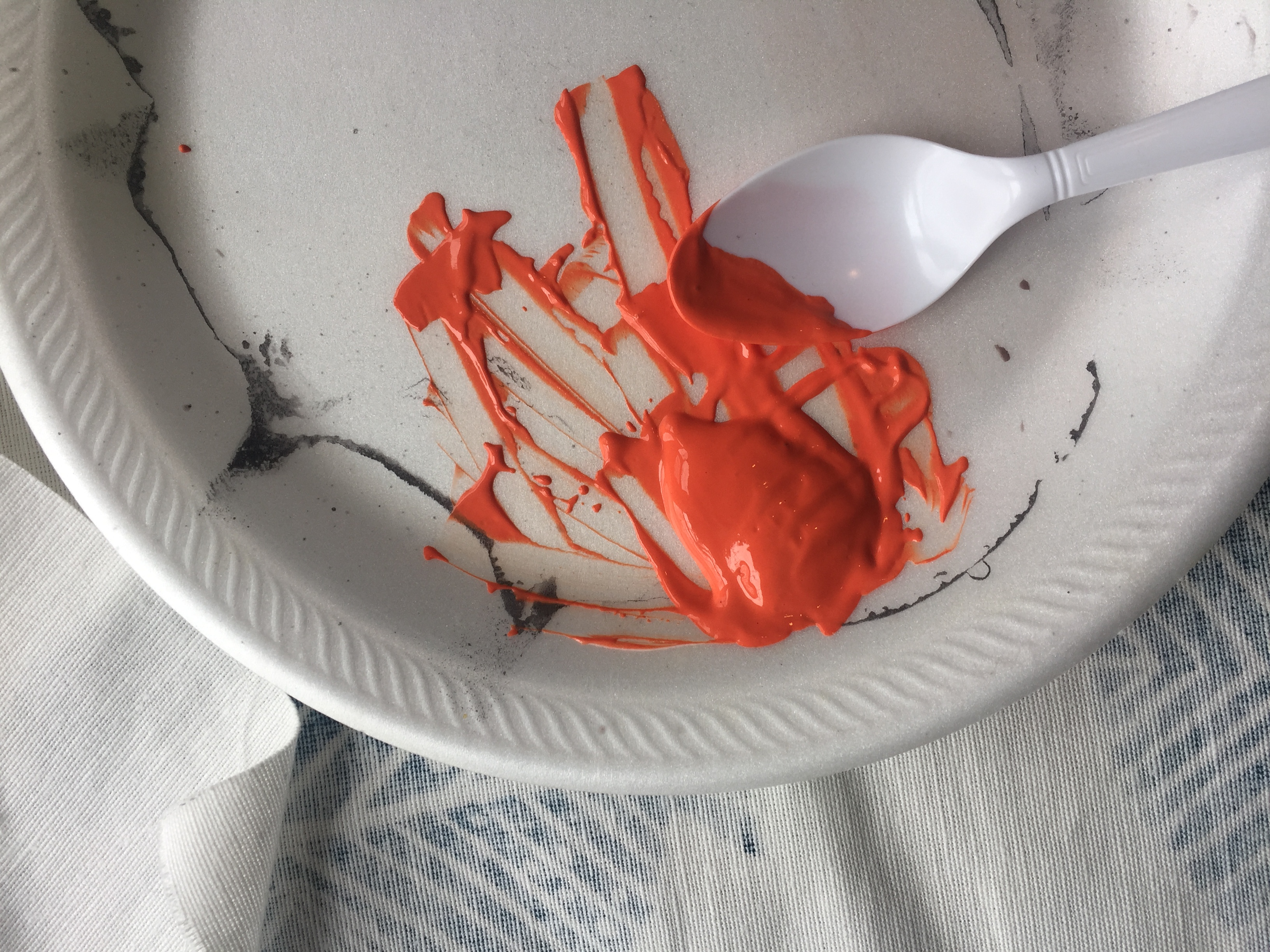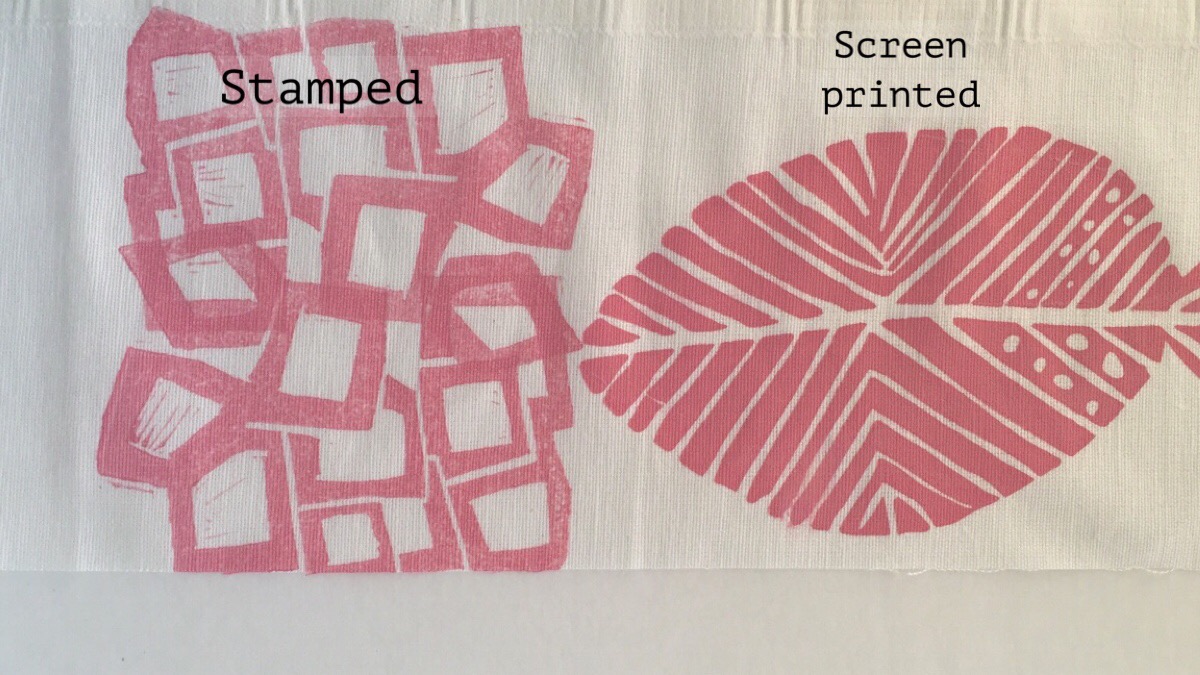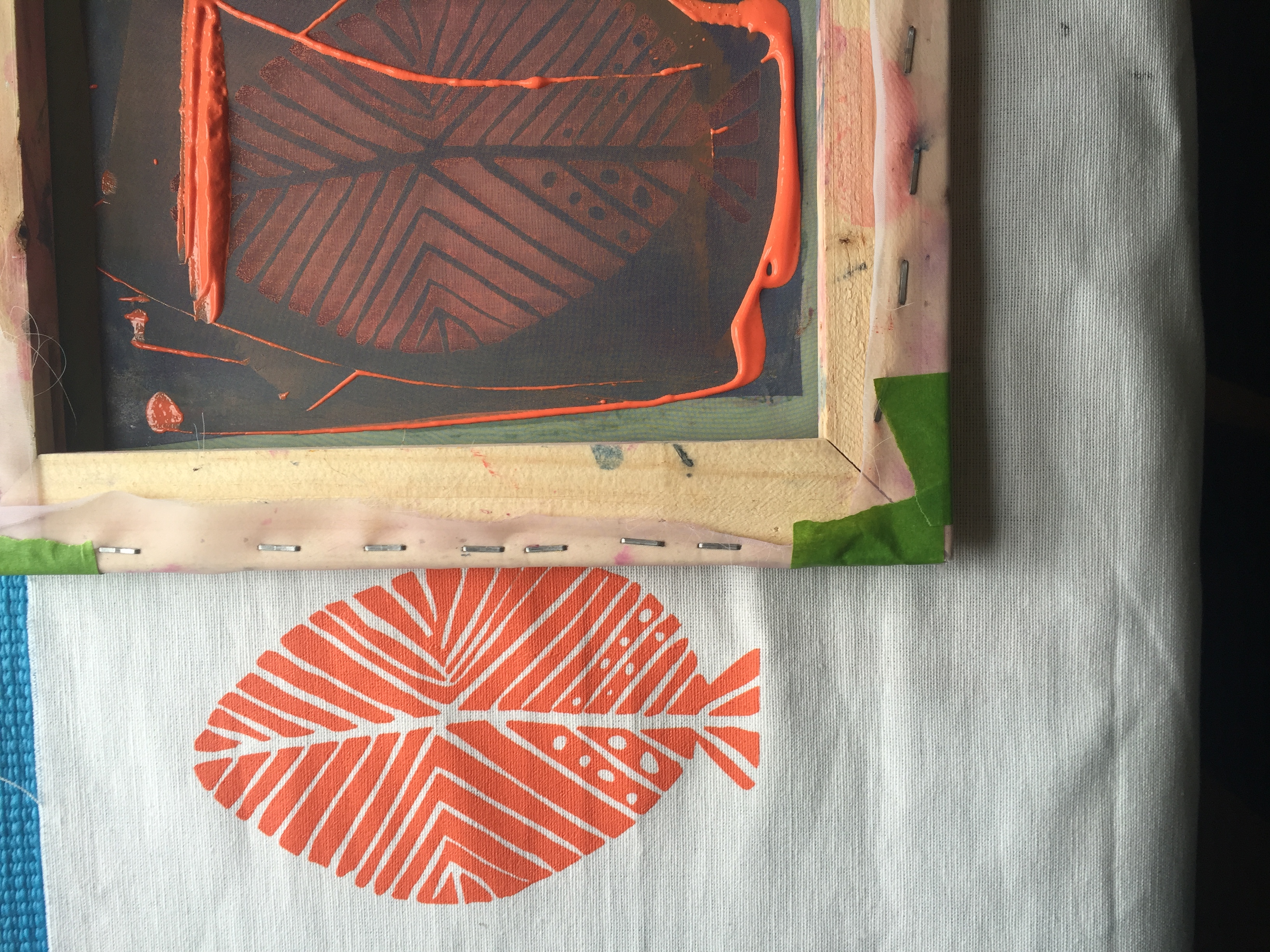A note about my experience on screenprinting fabric with latex house paint…
I have been screen printing fabric with latex house paint for at least 3 years now. I have successfully printed a lot of things: napkins, pillow covers, curtains, t-shirts, tote bags, etc. I have exclusively printed on cotton, linen, and ramie, so I can not speak for synthetic fabrics.
I hesitated sharing this information because
1.) I wanted to make sure I knew what I was doing before putting it out there, and
2.) I was not sure how it would be received. In the end, I figured, if it can help someone else, it’s worth the risk of an internet backlash (ha-ha!)
I mostly print on things that will not get a lot of washing, but I have successfully machine washed, and hand-scrubbed fabrics that I printed. I have found that it is best to wait at least a week or so, to let the paint cure, before attempting any washing.
So obviously, you can not just glop on some house paint onto your screen and expect a good print. If that was the case, everyone would be doing this already. There are a few reasons this would not work out.
- Latex paint, used in its pure form, is too runny to be pulled through the screen.
- Latex paint, used in its pure form, dries REALLY fast, and will gunk up your screen.
- Latex paint, used in its pure form will leave a nasty haze on your screen, because it dries so quickly.
- Latex paint, used in its pure form dries stiff on fabric, leaving a not very pleasant ‘hand.’ Because of this, it also tends to crack over time and washings.
- Latex paint, used in its pure form, *may not be* wash-fast. This is debatable.
I call these ‘challenges to overcome’.
In order to make latex house paint suitable for printing, it needs to be ‘modified’ and ‘extended.’
Modifying & Extending the Paint:
Extending the paint simply means diluting it. This means that you are not using the paint at full strength.
You will be diluting the paint with a thickener. Wait, what? Yes, you are thinning with a thickener. It will make complete sense, I promise.
Latex house paint is highly pigmented and can stand to be thinned. Strangely, the color is not noticeably lightened in this process.
Extending the latex house paint solves challenges #1-4. Extending the paint will:
- Thicken, duh. Now you can pull it thru the screen.
- The extender used will slow down the drying process.
- Because it will now dry slower, there’s less likelihood of it drying on your screen, leaving the haze of color, and possibly blocking the holes on your screen.
- Because the paint has now been extended, it will dry on the fabric with a much softer hand, and the paint will not crack on your fabric with repeated washings.
Modifying the paint just means that you will add textile medium. This solves challenge #5. to make the paint wash-fast.
Now, I’m of 2 minds regarding washability. I believe that latex paint is washable on fabric.
Think about the last time you got paint on your clothes while painting. How hard was it to get that paint out? Extremely.
I add textile medium for extra protection. I do not really believe that latex house paint needs textile medium to be wash-fast.
On the other hand, I’m nervous to leave it out.

So you want to know what I use to extend my paint, huh?
I have tried a variety of products to make my paint screen-able. Here are the ones that I have tried.
- Shaving Cream. The cheaper the better.
- Clear, non-flaking hair gel. The cheaper the better.
- Unscented Lotion (yes, lotion) The cheaper (think dollar store) the better.
- Mineral Oil
- Permaset Aqua Print Paste
So there ya have it.
In the next post, we will dive into more detail about each of these materials. If you have not, subscribe here so that you don’t miss it..



Hey so I mistakenly used latex paint in it’s pure form to run some prints because I was rushed and out of ink. SO, I now have a screen that has been blocked and won’t open up despite a few attempts with Speedball screen cleaner. Do you have any suggestions? Thanks a lot!
Oh no!
So sorry to hear that. I’d say try a paint stripper. I’ve had a little luck with the orange stuff that’s a little less toxic, but I think a straight up paint stripper might be your best bet.
That’s very helpful!! Thanks so much I’ll give it a try!
Good luck, let me know how it turns out!
VERY glad to find this… been wanting to try it for quite awhile, thank you.
btw, you came up #1 on google for ‘silk screen latex paint.
and you subscribe link didn’t work on the #1 latex page.
Thank you so much for your comment, Lou! I am so happy to hear that the information was of use to you. Thank you for letting me know about the google ranking and also for letting me know about the broken link. I am so sorry that it was glitched. I am fixing it right now.
I have not tried Elmer’s glue yet. What would you be using it for? That would probably affect how well it would work. As a textile medium, it might work. I suspect that textile medium is probably some sort of glue. As a way of applying other things, like say gold foil or glitter, it would probably also work…to a point. If the glue was a more permanent bond, not something that would re-wet with water.
I also just tried Liquitex heavy gloss gel to thicken the latex for screen/block printing. Worked like a charm but left the fabric a little stiff. If you are not printing on fabric, that is probably a non-issue.
Well, let me know if you try anything else!
AND I’ve been wondering about Elmer’s glue? Have you ever tried it?
Lou
Yetunde;
I have used Elmer’s for years for decoupage. I thin it a bit with DISTILLED water and it works weel iand is pretty water resistant dry.
It occurred to me when I did a search for ‘fabric medium’ and saw Mod Pouge listed. I have replace that with the elmer’s many times. Yo DO have to clean up pretty quick but you can adjust that with the water.
🙂
L.
Good Idea. Can I print signs with outdoor water base paints? What screen size do you use? Where is your youtube channel showing the process you use?
Thanks
Hello!
Thanks for checking out my post. I’m glad that you found it useful. To answer your questions:
1. I don’t see why you couldn’t use the water based paint to print signs, however, it depends. Will the signs be subjected to year round weather? the print might fade, I think. I think you could probably use the same process with any outdoor paint.
2. I use a variety of screen sizes, but the largest I’ve used is about 20×26. I think if you are printing long runs, you might want to add some sort of retarder to slow down the drying of the paint.
3. I have a Youtube channel, but alas, I have no screen printing videos on it. I just have a couple of random videos, but here it is, in case you still want to look at it: https://www.youtube.com/channel/UCrXHsBYXvVb4b86sGrt_ieg
Tootles!
Hi Yetunde, I love it that you are sharing your screen printing tips, I hope to do the same on a blog very soon.
I came across your blog because I was searching whether anyone else has tried house paint to screen print with. My client saw a house paint colour she liked so I went and bought a test pot, instead of trying to colour match with my other acrylic based paints.
Basically I am printing onto some leather, it doesn’t react the same as most fabrics because its not at all absorbent, therefore It doesn’t need heat curing and it wont be washed (being made into clutch bags). I will mix it with medium to make flow through the mesh.
My question to you is whether you think it will crack, have you tried leather at all?
Thanks. Sam.
Hi Sam!
Thanks for stopping by, and I’m so happy that you got some use out of my ramblings :).
I have tried the latex on leather, and it works well, no cracking. I have things I printed years ago that look the same still, so have at it!
Let me know how it works out for you.
This is crazy helpful! For years I have been trying to find a cheap way to screenprint or stamp t-shirts for my middle school students. Fabric paint is SO expensive! Some sites mention using glycerin, but then you see they don’t mean housepaint, but acrylic art paint.
Not only did you solve my money problem (I have a LOT of housepaint) but using your mediums (shaving cream!) works really well. Thank you. I don’t know why it took several hundred Googles over the years, but here we are.
Thanks you.
This information is awesome! Did you ever come up with those instructions on how to thin the latex paint? I’ve got a big project coming up and I’m desperate for an inexpensive stretchy medium to use. Also, have you been able to do fine detail with this method?
I usually thin with plain ol’ water if I need to thin. I have only sceeenprinted with 110 mesh. These days I mainly block print. I also mix with fabric medium if what I’m printing is going to be washed a lot. I have had great success with the shaving foam method, usually equal parts.
I can’t get the link to work but i want to screen print tshirts with latex house paint should I add deco fabric medium w shaving cream to the paint to screen print and it stay with out washing out or ruining my shirts
Hi!
I usually don’t even add fabric medium to the latex house paint, just shaving cream to thicken it up a little. I am wearing a sweatshirt right now that I printed with latex paint that I’ve washed over and over, and the paint holds up. I also blockprint with latex paint on fabric and I can actually get away with just thinning with water a little, with no shaving cream. If you are worried about ruining a shirt, I’d say try it first on a shirt that you don’t care about, just to get the hang of it.
Your creative experimentation is very helpful. You are a true artist with imagination…. and you are willing to share! My project is screen printing pen and ink style art onto painted aluminum 10×12 sheets, as wall art. I want to use house paint for the single-color accents on each piece because of the color choices available.
Thank you.
I’m so happy you got something out of it! I’d love to see your results!
Thank you for this. I am just getting into screenprinting and want to use house paint on wood but wasn’t sure how to go about it. Much more confident after reading this. Going to give it a go!
I love this! Thank you. I am printing some outdoor signs on wood for a political campaign and we have no budget. I tried plain old house paint because it is free (at my house), but it did run all over the place as you said and totally clogged the screen with just a couple of prints. I am totally going to try your additives. It will be a great inexpensive solution as ink can be crazy expensive. Also, it is nice to be able to recycle what we already have. Great ideas here!